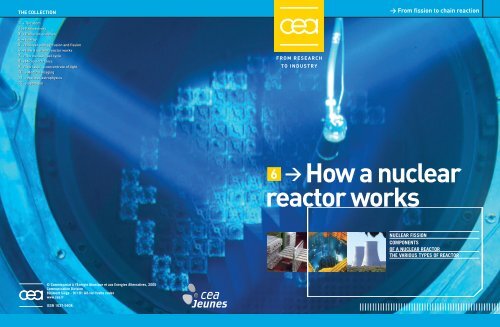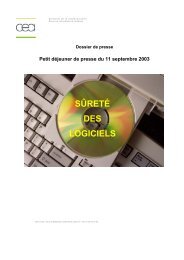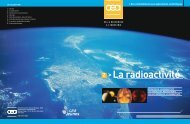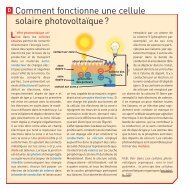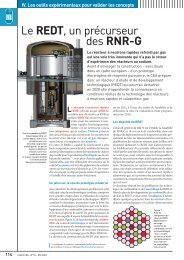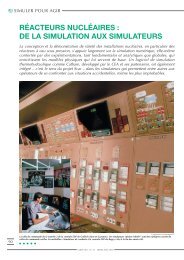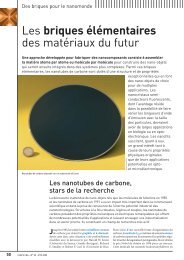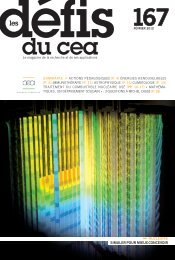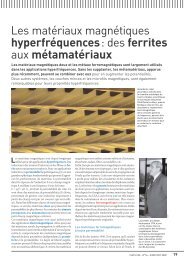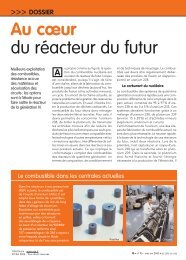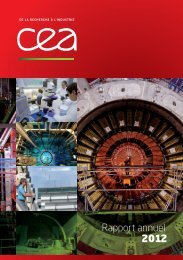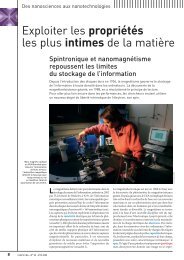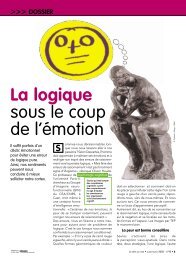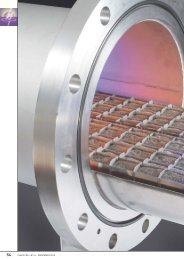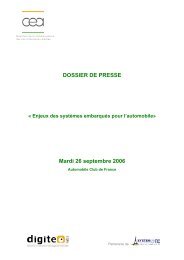CEA - How a nuclear reactor work
CEA - How a nuclear reactor work
CEA - How a nuclear reactor work
- No tags were found...
You also want an ePaper? Increase the reach of your titles
YUMPU automatically turns print PDFs into web optimized ePapers that Google loves.
2> CONTENTS > INTRODUCTION 3The builders of thefirst experimental<strong>reactor</strong>: LewKowarski (left) andFrédéric Joliot-Curie(right).The building housingthe first experimental<strong>reactor</strong>, Zoé.<strong>How</strong> a <strong>nuclear</strong><strong>reactor</strong> <strong>work</strong>sNUCLEAR FISSION 4Fissile atoms 5The energy liberatedduring fission 5Neutrons andthe chain reaction 6COMPONENTSOF A NUCLEAR REACTOR 7The fuel 8The control rods:Neutron traps 9The coolant: Carrier of heat 9The moderator:Neutron decelerator 10The steam generator:Heat exchanger 10THE VARIOUS TYPESOF REACTOR 11Reactor families 12The pressurisedwater <strong>reactor</strong> (PWR) 15The fast neutron<strong>reactor</strong> (FNR) 15The gas cooled<strong>reactor</strong> (GCR) 15© Médiathèque EDFLoading the <strong>reactor</strong> and closing the <strong>reactor</strong> vessel headat the Civaux <strong>nuclear</strong> power station (Unit 1).Overviewof the coreof a <strong>reactor</strong>.© Médiathèque EDF“The first <strong>nuclear</strong> <strong>reactor</strong> was constructedin the USA in 1942. The first French <strong>reactor</strong>came into operation six years later.”introductionstation is a factory that manufac-Apower tures electricity. Some power stations burnfossil fuels, some are driven by water… andsome use <strong>nuclear</strong> energy. All generate electricityin the same way by using a turbine to drive analternator. The electricity is generated in thealternator. The differences lie in the methodused to drive the turbine. In a hydro-electricpower station, water from a dam drives the turbinedirectly. In traditional power stations, afossil fuel (coal, natural gas or oil) is burnedto convert water into steam. The steam thendrives the turbine. In a <strong>nuclear</strong> power station,uranium nuclei are used in place of the fossilfuel. The heavy uranium nuclei break down,releasing the energy needed to boil the water.The steam is then used to drive a turbine inthe same way as in a traditional power station.The first <strong>nuclear</strong> <strong>reactor</strong> was constructed byEnrico Fermi in the USA in 1942. It consistedof a stack of 6 tonnes of metallic uranium,34 tonnes of uranium oxide and 400 tonnesof graphite. The ‘Fermi pile’ (so-called becauseof its stacked construction) generated a poweroutput of just half a watt. In France, the firstexperimental <strong>reactor</strong>, Zoé, was built by the <strong>CEA</strong>at their research centre in Fontenay-aux-Roses.This <strong>reactor</strong> became operational for the firsttime on the 15 th of December 1948. Thepower output was increased to 150 kW in 1953and the <strong>reactor</strong> was shut down in 1976. TheZoé <strong>reactor</strong> building is now used as a museumdevoted to the atom.Modern French electricity generating <strong>reactor</strong>sdeliver between 900 and 1,450 megawatts*of electricity. Within the <strong>reactor</strong>, the steam generatorproduces the heat needed to turn waterinto steam. The other components (turbine,alternator, etc.) are similar in all types of powerstation.* Megawatt: One million watts.From fission to chain reactionDesigned and produced by Spécifique - Cover photo by © PhotoDisc - Illustrations by YUVANOE - Printed by Imprimerie de Montligeon - 03/20056 > <strong>How</strong> a <strong>nuclear</strong> <strong>reactor</strong> <strong>work</strong>sFrom fission to chain reaction6 > <strong>How</strong> a <strong>nuclear</strong> <strong>reactor</strong> <strong>work</strong>s
10 > COMPONENTS OF A NUCLEAR REACTOR11© Framatome/G. LiesseTransporting a steam generator.THE MODERATOR:NEUTRON DECELERATORIn addition to the enclosed fuel rods, thecoolant and the control rods, most <strong>reactor</strong>salso contain a moderator (see the diagram onpage 9). The moderator slows down theneutrons as they are often too energetic totrigger new fission reactions effectively.Because of their high energy, these neutronsmove at high speed (20,000 km/s). They areknown as fast neutrons.If a neutron is travelling at a very high speed,it can pass very close to a uranium atomwithout being captured. This makes it difficultto obtain sufficient fission reactions. In“The moderator slowsthe neutrons so thatthey can be captured byatoms and trigger afission reaction.”order to obtain a greater number of fission reactionseasily, the neutrons must be slowed downconsiderably, from 20,000 km/s to a speed ofaround 2 km/s. Neutrons travelling at suchspeed are called slow neutrons or thermalneutrons. Neutrons are slowed when they passthrough a material made up of atoms with nucleithat do not absorb neutrons. Just like a billiardball, the neutrons loose energy each time theycollide and bounce off one of these nuclei.The neutrons are slowed more rapidly if theycollide with light nuclei with a mass similar tothat of a neutron, such as hydrogen.The material containing these atoms is calledthe moderator.In an efficient <strong>reactor</strong> design, the fuel and themoderator are positioned alternately; fuel,moderator, fuel, moderator, etc.THE STEAM GENERATOR:HEAT EXCHANGERThe coolant is heated by contact with the fuel.It leaves the <strong>reactor</strong> core at a temperature ofbetween 300 and 550°C.The coolant is then used to heat water in the“steam generator”. The water boils andproduces steam. This steam is used to drivea turbine connected to an alternator generatingelectricity. After it leaves the turbine,the steam is condensed back into water in acondenser cooled by river water.© Médiathèque EDFTHE CHOICE OF THE COMBINATION OF FUEL,COOLANT AND MODERATOR DETERMINESTHE REACTOR FAMILY TO WHICH THE POWER STA-TION BELONGS.The varioustypes of <strong>reactor</strong>From fission to chain reaction6 > <strong>How</strong> a <strong>nuclear</strong> <strong>reactor</strong> <strong>work</strong>sFrom fission to chain reaction6 > <strong>How</strong> a <strong>nuclear</strong> <strong>reactor</strong> <strong>work</strong>s
12> THE VARIOUS TYPES OF REACTOR> THE VARIOUS TYPES OF REACTOR“Pressurised water <strong>reactor</strong>s produce halfof the world’s <strong>nuclear</strong> electricity.”13© Médiathèque EDFREACTOR FAMILIESA <strong>nuclear</strong> power station is designed to produceelectricity from <strong>nuclear</strong> fuel. <strong>How</strong>ever, althoughthey all share the same basic principle ofoperation, there are several different familiesof <strong>nuclear</strong> <strong>reactor</strong>s.The Civaux <strong>nuclear</strong>power station (Vienne).There are four main components of a <strong>reactor</strong>core:• The fuel assemblies, in which fission reactionstake place.• The coolant fluid to carry the heat out of the<strong>reactor</strong>.• The moderator (except in the case of a fastneutron <strong>reactor</strong>) used to slow down the neutrons.• The control rods to control the chain reaction.Each of these components, and especially thefirst three, can exist in a number of differentforms. For example, the coolant may be a gas(e.g. carbon dioxide) or a liquid (e.g. water).<strong>How</strong>ever, of the many possible combinations offuel, coolant and moderator, only a few havebeen used to manufacture actual <strong>reactor</strong>s. Themain types of <strong>reactor</strong>s are shown in the tableon the next page.“Although they allshare the same basicprinciple of operation,there are severaldifferent familiesof <strong>nuclear</strong> <strong>reactor</strong>s.”REACTOR FAMILIESTYPE OF REACTOR FUEL MODERATOR COOLANTUNGG <strong>reactor</strong>(Natural Uranium Graphite Gas Natural uranium Solid carbon Carbon dioxidein English) (0.7% uranium 235) (graphite)First type of <strong>reactor</strong> to be developedin France. All the <strong>reactor</strong>s of thisgeneration are shut down,the last one in 1994.CANDU <strong>reactor</strong>Type of <strong>reactor</strong> developed in Canada. Natural uranium Heavy water* Pressurised heavy waterRBMK <strong>reactor</strong>“Reactor Bolshoi Moschnosti Kanalynyi” Enriched uranium Carbon (graphite) Boiling wateror “Channelised Large Power Reactor” (1.8% uranium 235)in English. This type of <strong>reactor</strong>accounts for 40% of the <strong>nuclear</strong> powerstations in states of the former USSR,(for example, Chernobyl).Boiling water <strong>reactor</strong> (BWR)Reactor family developed in the USA, Enriched uranium Boiling water in the coreJapan and Sweden (3% uranium 235)Pressurised water <strong>reactor</strong> (PWR)The most common type Enriched uranium Pressurised liquid water. The pressurised waterof <strong>reactor</strong> in the world. (3% uranium 235) acts as both coolant and moderator.It was also developed inthe ex-USSR as the “VVER”.Fast neutron <strong>reactor</strong> (FNR)This type of <strong>reactor</strong> does not use a Enriched uranium None Liquid sodium.moderator. The neutrons are not or plutonium Does not slowslowed down. There is one prototypethe neutrons<strong>reactor</strong> of this type in France,the Phénix <strong>reactor</strong> (250 MWe).*Heavy water: Water in which the hydrogen atom has been replaced by deuterium, aheavy isotope of hydrogen (see The atom booklet).From fission to chain reaction6 > <strong>How</strong> a <strong>nuclear</strong> <strong>reactor</strong> <strong>work</strong>sFrom fission to chain reaction6 > <strong>How</strong> a <strong>nuclear</strong> <strong>reactor</strong> <strong>work</strong>s
14> THE VARIOUS TYPES OF REACTOR > THE VARIOUS TYPES OF REACTOR 15ControlrodsDiagram showing the operation of a pressurised water <strong>reactor</strong>Steam generator(heat exchanger)PressuriserSteamBoiling waterTurbineAlternator“Some types of <strong>reactor</strong> use heliumas the coolant, carrying heat outof the <strong>reactor</strong> and stabilising thetemperature.”ReactorvesselThe Phénix fast neutron <strong>reactor</strong>.© Médiathèque EDFNuclear <strong>reactor</strong>Hot coolant(320 °C)Reactor corePumpCold coolant (280 °C)PumpCondenserCooler:river or sea water,or airCruas <strong>nuclear</strong> power station–<strong>reactor</strong> building–fuel rod loading probe in the open <strong>reactor</strong> vessel.THE PRESSURISED WATERREACTOR (PWR)This is the most widely used <strong>reactor</strong> type inthe world. Pressurised water <strong>reactor</strong>s producearound half of the world’s <strong>nuclear</strong> electricity.In France, all the <strong>nuclear</strong> <strong>reactor</strong>s except Phénix<strong>reactor</strong> are PWR types. Thirty-four deliver 900MWe (megawatts of electricity), 20 deliver1,300 MWe and 4 deliver 1,450 MWe.THE FAST NEUTRON REACTOR(FNR)The fast neutron <strong>reactor</strong> was designed to makea more complete use of fissile material in thefuel (uranium and plutonium) than in <strong>reactor</strong>susing thermal neutrons.The coolant may be a liquid metal, such assodium (Phénix) or a gas such as helium.They have the advantages of being able toproduce more fissile material (breeder) or toincinerate long-lived nuclei (actinides).“Fast neutron<strong>reactor</strong>s do notuse a moderator.”© Photothèque EDF/P. BérengerTHE GAS COOLED REACTOR (GCR)The use of helium as the coolant makes itpossible to design <strong>reactor</strong>s with a direct cycle.In this type of <strong>reactor</strong>, the very hot helium drivesa turbo-alternator directly without the need foran intermediate heat exchanger, therebyincreasing the thermodynamic efficiency. Thistype of <strong>reactor</strong> has been considered in the past,but recent developments in gas turbinetechnology have led to a revival in interest.They are suitable for use in economic and safesmall-scale installations (100 to 300 MWe).This type of <strong>reactor</strong> is also capable of operatingwith fast neutrons giving it all the additionaladvantages of the FNR.From fission to chain reaction6 > <strong>How</strong> a <strong>nuclear</strong> <strong>reactor</strong> <strong>work</strong>sFrom fission to chain reaction6 > <strong>How</strong> a <strong>nuclear</strong> <strong>reactor</strong> <strong>work</strong>s


